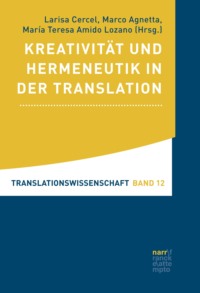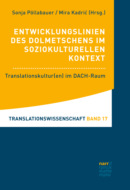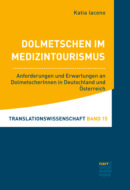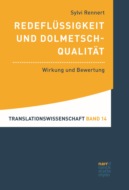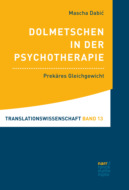Kitabı oku: «Kreativität und Hermeneutik in der Translation», sayfa 7
4 The Creative Reading of the Translated Poem
If a process of creative reading for translation has informed the writing of the translated poem, there is hope its readers will be able to engage in a similar way with the poem before them. Furthermore, creative reading of the translated text means that the reader is aware there was an original that gave rise to it. To make such awareness more likely, background for the original poem needs to be supplied so that the new readers’ cognitive context contains at least some elements that were likely to have formed part of the cognitive context of the original readers. I can only indicate here one or two such places in the translated poem where considerations of the creative engagement possible for new readers have been particularly important. There are of course instances, in the translation, of sound repetition and ambiguity that attempt to convey some of the obsessiveness and slipperiness of the original. Words such as “waking … playing”, “lie … righted”, “unsaid … heads” are in part chosen with a view to repeated sound. But much more important are the points of ambiguity in the poem that might lead to explorations of language itself. The words “righted”, “crown”, “pickings” and “glint” will serve to illustrate some of this ambiguity and the creatively engaged reading to which it is hoped they can give rise.
“Righted” in line 3 was chosen because the word needs to express the result of an action that has placed the corpses upright. “To right” is normally “to restore to an upright position”, as in “he righted the vase that had fallen over”. But “to right” also means “to put right”, and thus “righted” has connotations of being morally upright, which perhaps they were not, but which they were assumed by the rest of society to be, or had been placed so as to appear to be, and which in the speaker’s mind they may appear to be in contrast to his own inability to act.
“Crown” was chosen for “Prunk” in line 5, because, as noted under point (3) above, “Prunk” is something ostentatious, suggesting embellishment, and the word is etymologically related to verbs meaning “to shine”. But a crown is also the top of a tree in German (Baumkrone), and the corpses are explicitly addressed as trees in line 4. There are further connotations of the crown of thorns, especially given the contrast to “Bettel” (that which a beggar has collected). The crown is an extremely potent image in Judaism, where, in the Kabbalistic symbolism that exerted great influence on Celan (cf. Felstiner 1995: 235–241), it is at the top of the tree that symbolises the sefirot, or manifestations of God (Scholem 1971: 44; 70). Thorns are symbols of uncultured land, as well as of trial and difficulty, in both Jewish and Christian traditions (see Gheerbrandt et al. 1996: 262, 991) and the image of the crown of thorns drew on both these symbols. In Celan’s other poetry, images of a crown, and of thorns, often in juxtaposition with images of blood, are common. “Prunk” is related to “Pranger”, a pillory, a pillar or stocks, or whipping post, used for public humiliation of criminals. “Prunk” thus suggests in German not only the embellishments of office but also (though this etymological connection would not be known to most German readers) the need for public acknowledgement of crimes, and is thus, in the original poem, linked by its connotations both to “die Axt an etwas legen”, literally “to take an axe to something”, and to “aufgerichtet”, a connotation possibly stronger in the English “righted”.
“Pickings” was used in line 6 for “Bettel”, literally, “that which a beggar has collected”. In conjunction with axes, it may for the English reader have the connotations of picks as working tools, as “Äxten” certainly would have had for Celan, not least because his parents were made to work as stone quarriers in the slave-labour camp in the Ukraine where they died.
“Glint” is used in the final line for “blinken”. Originally meaning “to look askance, let one’s glance slide off”, it is related to “glance” and “glide” in English, and to similar words in French and Dutch. Like “blinken”, it picks up the sense of “prangen” (to shine) that linguistically lies behind “Prunk”, and is semantically (though not of course etymologically) connected to “crown”. There is an ambiguity about “glint”, especially because of its original meaning, “to let one’s glance slide off” something, as suggested by an etymology which links it to “blink” in English (see Onions et al. 1966: 401), the closest obvious equivalent of “blinken” in German, a word that appears in the final line. That connotation of a sliding glance is still present in our knowledge of words such as “glisser”, “to slip” in French, the root of many technical terms in sports such as skiing and climbing. “Glint” may thus suggest, as many of Celan’s poems do, the need to look at things indirectly, to let our glance slide off them. Another example is “Auge der Zeit” (Time’s Eye) from the same collection (Celan 1982: 51). In this poem, though, indirect looking is not just a way of preserving one’s sanity in the face of traumatic events. It is also a source of guilt: if we do not look at things directly we are merely “playing” with axes but not actually setting to work with them. “Glint” in English probably has connotations of gleaming, of embellishment, or of a sudden hint or suggestion, more than of “glance”. However, many words hold connotations in their sound (cf. Andersen 1998), a fact which may or may not be related to their etymology. “Glint” is part of a series of words “hint”, “squint”, “tint” that all suggest something fleeting and subtle.
The English translation, it is hoped, will allow engaged reading that considers the links between words in the poem and words suggested, and the ambiguities of thought to which particular words such as “righted” give rise, as well as the force of the poetic images. But the translation should also allow the reader to be aware of the original poem that lies behind it. This might simply be an awareness that it exists, that the English poem is a re-telling, or it may go beyond this to consider links between English and German that were already in the original, such as some of those mentioned above. The degree of awareness of the original poem does not depend on the reader’s knowledge of the source language, but much more on such things as the presentation of the translated poem (monolingually or bilingually, for example), or discussion of translation in the book in which the poem appears, for example in a Translator’s Preface.
5 Conclusion
The examples I have examined here from Celan’s original poem and my translation suggest that part of the way such poems have cognitive effects is in giving rise to creative, engaged reading. This is reading that is not afraid to analyse the original, or the translation, and to work out how words and structures achieve these effects. But it is also not afraid to attempt a reconstruction of a particular state of mind that gave rise to the poem and is reflected in its mind-style. Here that particular state of mind in the case of the original poem is traumatised, obsessive and filled with feelings of guilt.
A translator is by nature an interpreter, as is every reader. When we read anything we interpret it, giving it a meaning that we assume is a combination of what the writer meant and what it means to us. Translating poetry in particular involves, I have argued here, an understanding of translation as recreation that is accurate in that it allows access to the poetics that inform the poem. Reading for translation also involves a consideration of what it means when texts cross language-boundaries and it leads to a deeper understanding of the connection between languages, something that is particularly important to Holocaust poetry with its Central European origins and the multilingual background of so many of its writers. It involves imagining what the text will become in a new language and a new context, and how the new language and context will be affected.
The intellectual and emotional engagement the translator expends upon the original is thus by nature creative. It is no use, for example, to see equivalences at surface level with no thought for connotation, etymology, or the claims of semantics that link a particular word or phrase with other elements of language or the poet’s work or the work of others. But it is also no use being constrained by a superficial understanding of the original text. Creative engagement with the original text leads to analysis and research. If there seems, for example, a connotation of the crown of thorns in the poem, we cannot simply discard this because the poet was Jewish. No poet is influenced only by their own immediate cultural background. But, more than this, research will show the pre-Christian and extra-Christian origins of this image, which are always potentially available to any reader, whether or not they formed part of the cognitive context of the original poet.
Etymology, similarly, is not only a way to dig deeper into our own language, but a means to explore the common origins of languages and a way to uncover the uncertainty of meaning. It thus leads to an understanding of the multicultural origins of language.
It is to be hoped that, if the translation of poetry is in essence the translation of poetics, the translated poem will have its own poetics, its own system that informs the way the poem is put together. Then it can be hoped that some of the creative possibilities in reading the original which were available to the translator will also be available to the new readers of the translated poem.
References
Andersen, Earl (1998): A Grammar of Iconism. London: Associated University Presses.
Attridge, Derek (2004): The Singularity of Literature. London: Routledge.
Benjamin, Walter (1971): Versuche über Brecht. Frankfurt am Main: Suhrkamp.
Benjamin, Walter (1992): „Über Sprache überhaupt und über die Sprache des Menschen”. In: Tiedemann, Rolf (ed.): Walter Benjamin. Sprache und Geschichte. Stuttgart: Reclam, 30–49.
Benjamin, Walter (2012): “The Translator’s Task”. Tr. by Steven Rendall. In: Venuti (ed.), 75–83.
Boase-Beier, Jean (2015): Translating the Poetry of the Holocaust. Translation, Style and the Reader. London: Bloomsbury.
Brecht, Bertolt (1991): Dreigroschenroman. Frankfurt am Main: Suhrkamp.
Brodzki, Bella (2007): Can These Bones Live? Translation, Survival, and Cultural Memory. Stanford: Stanford University Press.
Cassian, Nina (tr.) (2015): Romanian Poems by Paul Celan. Rhinebeck: Sheep Meadow Press.
Celan, Paul (1952): Mohn und Gedächtnis. Stuttgart: Deutsche Verlags-Anstalt.
Celan, Paul (1982): Von Schwelle zu Schwelle. Stuttgart: Deutsche Verlags-Anstalt.
Chalfen, Israel (1979): Paul Celan. Eine Biographie seiner Jugend. Frankfurt am Main: Insel Verlag.
Derrida, Jacques (2005): Sovereignties in Question. The Poetics of Paul Celan. Ed. by Thomas Dutoit and Outi Pasanen. New York: Fordham University Press.
Fairley, Ian (tr.) (2007): Paul Celan. Snow Part. Schneepart. And Other Poems. Manchester: Carcanet.
Fauconnier, Gilles / Turner, Mark (2002): The Way We Think. New York: Basic Books.
Felman, Shoshana (1992): “Education and Crisis, or the Vicissitudes of Teaching.” In: Felman, Shoshana / Laub, Dori (eds.): Testimony. Crises of Witnessing in Literature, Psychoanalysis, and History. New York / London: Routledge, 1–56.
Felstiner, John (1995): Paul Celan: Poet, Survivor, Jew. New Haven: Yale University Press.
Felstiner, John (tr.) (2001): Selected Poems and Prose of Paul Celan. New York / London: W.W. Norton.
Fioretos, Aris. (ed.) (1994): Word Traces: Readings of Paul Celan. Baltimore: Johns Hopkins University Press.
Fowler, Roger (1977): Linguistics and the Novel. London: Methuen.
Frankel, Ellen / Teutsch, Betsy (1995): The Encyclopedia of Jewish Symbols. Columbia: Jason Aronson.
Frankovich, Nicholas (ed.) (1997): The Columbia Granger’s Index to Poetry in Anthologies. [11th Edn.] New York: Columbia University Press.
Gheerbrandt, Alain / Chevalier, Jean / Buchanan-Brown, John (1996): The Penguin Dictionary of Symbols. London: Penguin.
Gubar, Susan (2003): Poetry after Auschwitz. Remembering What One Never Knew. Bloomington: Indiana University Press.
Hamacher, Werner (1994): “The Second of Inversion: Movements of a Figure through Celan’s Poetry.” In: Fioretos, Aris (ed.): Word Traces: Readings of Paul Celan. Baltimore / London: The Johns Hopkins University Press, 219–263.
Hamburger, Michael (tr.) (2007): Poems of Paul Celan. London: Anvil.
Hermans, Theo (2007): The Conference of the Tongues. Manchester: St Jerome Publishing.
The Holy Bible (2011): The King James Version, Illustrated. London: HarperCollins.
Iiyoshi, Mitsuo (1990): 閾から閾へ -パウル・ツェラン詩集 Tokyo: ShityoSha.
Jakobson, Roman (1960): “Closing Statement: Linguistics and Poetics.” In: Sebeok, Thomas (ed.): Style in Language. Cambridge: MIT Press, 353–358.
Jakobson, Roman (1990): On Language. Ed. by Linda R. Waugh and Monique Monville-Burston. Cambridge: Harvard University Press.
Kale, Tessa (ed.) (2007): The Columbia Granger’s Index to Poetry in Anthologies [13th edn.]. New York: Columbia University Press.
Kirsten, Wulf / Seeman, Annette (trs.) (2012): Der gefesselte Wald. Gedichte aus Buchenwald. Göttingen: Wallstein.
Klemperer, Victor (2015): LTI. Notizbuch eines Philologen. Stuttgart: Reclam.
Kraft, Ruth (1986): “Vorwort”. In: Paul Celan. Gedichte 1938–1944. Frankfurt am Main: Suhrkamp, 5–8.
Lakoff, George / Johnson, Mark (1980): Metaphors We Live By. Chicago: University of Chicago Press.
Lakoff, George / Turner, Mark (1989): More Than Cool Reason. A Field Guide to Poetic Metaphor. Chicago: University of Chicago Press.
Langer, Lawrence (ed.) (1995): Art from the Ashes. A Holocaust Anthology. Oxford: Oxford University Press.
Martin, Elaine (2011): Nelly Sachs. The Poetics of Silence and the Limits of Representation. Berlin / Boston: de Gruyter.
Oatley, Keith (2011): Such Stuff of Dreams: The Psychology of Fiction. Chichester: Wiley-Blackwell.
Onions, Charles / Friedrichsen, George / Burchfield, Robert (1966): Oxford Dictionary of English Etymology. Oxford: Clarendon Press.
Patrut, Iulia-Karin (2006): Schwarze Schwester – Teufelsjunge. Ethnizität und Geschlecht bei Paul Celan und Herta Müller. Köln / Weimar / Wien: Böhlau.
Rich, Adrienne (1993): Poetry and Commitment. New York: W.W. Norton.
Richards, Ivor Armstrong (1960): Principles of Literary Criticism. London: Routledge and Kegan Paul.
Rothberg, Michael (2000): Traumatic Realism. The Demands of Holocaust Representation. Minneapolis: University of Minnesota Press.
Rowland, Antony (2005): Awkward Poetics in the Work of Sylvia Plath, Geoffrey Hill, Tony Harrison and Ted Hughes. Edinburgh: Edinburgh University Press.
Rowland, Antony (2014): Poetry as Testimony. Witnessing and Memory in Twentieth-Century Poems. New York / London: Routledge.
Rudy, Stephen (1997): “Introduction”. In: Roman Jakobson. My Futurist Years. Ed. by Bengt Jangfeldt and Stephen Rudy. New York: Marsilio, IX–XVI.
Rykhlo, Petro (tr.) (2014): Paul Celan. Vid poroha do poroha. Chernowitz: Knyhy-XXI.
Saussure, Ferdinand de (1916): Cours de linguistique générale. Ed. by Charles Bally and Albert Sechehaye. Lausanne: Payot.
Schlant, Ernestine (1999): The Language of Silence. West German Literature and the Holocaust. New York / London: Routledge.
Schleiermacher, Friedrich D. E. (2012): “On the Different Methods of Translating”. Tr. by Susan Bernofsky. In: Venuti (ed.), 43–63.
Scholem, Gershom (1971): The Messianic Idea in Judaism. New York: Schocken Books.
Short, Mick (1996): Exploring the Language of Poems, Plays and Prose. London: Longman.
Siever, Holger (2015): „Schleiermacher über Methoden, Zweck und Divination”. In: Cercel, Larisa / Şerban, Adriana (eds.): Friedrich Schleiermacher and the Question of Translation. Berlin / Boston: de Gruyter, 153–172.
Stockwell, Peter (2013): “The Positioned Reader”. In: Language and Literature 22/3, 263–277.
Stolze, Radegundis (1994): Übersetzungstheorien: Eine Einführung. Tübingen: Narr.
Stolze, Radegundis (2011): The Translator’s Approach. An Introduction to Translational Hermeneutics. Berlin: Frank und Timme.
Stolze, Radegundis (2015): Hermeneutische Übersetzungskompetenz. Grundlagen und Didaktik. Berlin: Frank und Timme.
Turner, Mark (1996): The Literary Mind. The Origins of Thought and Language. Oxford: Oxford University Press.
Venuti, Lawrence (ed.). (2012): The Translation Studies Reader [3rd edn.]. London: Routledge.
Verdonk, Peter (2002): Stylistics. Oxford: Oxford University Press.
Wales, Katie (2001): A Dictionary of Stylistics. [2nd edn.] London: Longman.
Young, David (tr.) (2010): Paul Celan. From Threshold to Threshold. Washington D.C.: Marick Press.
Sprachgefühl und das Übersetzen von Kinderliteratur
Wolfgang Pöckl (Innsbruck)
Abstract: Translation of children’s literature is generally considered, often even by the translators themselves, a relatively undemanding and hence low prestige activity. Therefore it usually does not play a role in translator training.
Young German-speaking readers often notice, however, that children in the books they read do not speak “their” language. This can be due to the fact that the translator does not have the experience of how children of a certain age speak in everyday life. But German translators have to keep in mind that German is a pluricentric language. This means that the translation will not be satisfactory for all children of the German speech community. The magic formula could be intralingual translation but this is not only an economic question. Translators are not at all used to translating from one standard into another and have to appeal to their linguistic instinct. This is a constantly creative activity as long as they lack routine in this form of translation.
Keywords: Children’s literature, pluricentric languages, empathy, intralingual translation, linguistic instinct (Sprachgefühl).
1 Das Kinderbuch – ungeliebtes Kind der Übersetzer?
Mehrmals und in verschiedenen Ländern wurde ich in den vergangenen Jahren Ohrenzeuge von Gesprächen zwischen Übersetzerinnen, die sich ihren Lebensunterhalt vor allem als Freiberuflerinnen verdienen, über die jeweilige Auftragslage. Dabei ist mir aufgefallen, dass oft berichtet wurde, man sei gerade mit einem Kinderbuch beschäftigt, was an sich nicht verwunderlich ist, da die Übersetzungstätigkeit auf diesem Sektor außerordentlich intensiv ist. Was mich dagegen überrascht hat, war, dass diese Auskünfte praktisch immer von einem resignativen Unterton begleitet waren: Die Auftraggeber hätten im Moment leider nichts Interessanteres, aber ein Kinderbuch sei besser als nichts, und so füge man sich wohl oder übel in sein Übersetzerschicksal. Doch welche Gründe kann es geben, dass das Übersetzen von Literatur für Kinder als dermaßen unattraktiv empfunden wird?
Zunächst muss man natürlich bedenken, dass solche Aufträge selten umfangreich sind. Kinderbücher haben weniger Text als Romane für Erwachsene. Üblicherweise hat man sich auch noch an Illustrationen zu orientieren, die ja nur in den seltensten Fällen für fremdsprachige Ausgaben modifiziert oder gar ersetzt werden (dürfen). Solche zusätzlichen Erschwernisse kann man aber selten in Rechnung stellen, so dass die Verdienstmöglichkeiten bei einem einzelnen Titel naturgemäß beschränkt sind.
Ein weiteres Motiv für den geringen Enthusiasmus ist die weit verbreitete – und anscheinend auch von ÜbersetzerInnen selbst vielfach geteilte – Auffassung, das Übersetzen von Kinderbüchern sei wenig anspruchsvoll. Selbst Kultbücher wie Der kleine Prinz, seit kurzem gemeinfrei, werden von Übersetzern offenbar als ‚Kinderspiel‘ betrachtet. So beschrieb Hans Magnus Enzensberger seine Neuübersetzung des französischen Klassikers als „eine Sache für die linke Hand“. Einen großen Kulturauftrag scheint er nicht empfunden zu haben: „Das wirft man den Leuten mit Kindern jetzt mal hin, und dann können die damit machen, was sie wollen“ (Felicitas von Lovenberg, online).1
Aus Übersetzungen für die linke Hand ist wenig Prestige abzuleiten. Im Curriculum von ÜbersetzerInnen nehmen solche Publikationen demnach keinen bedeutenden Rang ein. Gegenteilige Lippenbekenntnisse bleiben Randbemerkungen der Fachliteratur. So schrieb Hans Joachim Störig im Vorwort zur ersten deutschen Anthologie übersetzungstheoretischer Äußerungen:
Im Bereich der literarischen Übersetzung […] gibt es Zweige, die ihre eigenen Probleme haben und hier insoweit nicht behandelt werden. Dazu gehören die Probleme der Filmsynchronisation. Dazu gehören Kinderbücher: Es gibt nur noch eines, das schwerer ist als ein gutes, zum Klassiker bestimmtes Kinderbuch zu schreiben – so ist gesagt worden –, nämlich ein gutes Kinderbuch gut zu übersetzen. (Störig 1963: XVIf.)
